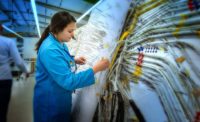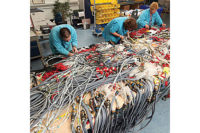A significant challenge facing automotive harness manufacturers is how to manage complex wire harnesses from design and manufacturing to delivery. The most desired method is the German kundenspezifischer kabelbaum (KSK) concept, which translates to “customer-specific wire harness.”
A KSK harness is a customized wiring harness that is manufactured based on customer specifications. Wire harnesses are made according to an individual list of modules, and each has an individual part number.
It allows individual harnesses to be manufactured for a specific vehicle, precisely supporting the customer’s requirements. While KSK harness are more profitable and less wasteful, they present numerous challenges for design, assembly and test.
“Rather than make all harnesses the same to accommodate all functions and accessories in a vehicle, each harness is made for the customer’s specific vehicle order,” says Rob Boyd, head of product management at Schleuniger Inc. “It includes the wire sets for the accessories and features that were ordered.
“KSK has been implemented for years,” explains Boyd. “It is intended to minimize the amount of wire in a vehicle by only including what is necessary.
“However, it adds much more variety to the production line because each harness might be slightly different from the next,” warns Boyd. “Therefore, much more planning and control is required.”
European Tradition
While the KSK concept has been around for several decades, it tends to be more popular in Europe. That’s because of the way that vehicles are traditionally sold.
“In the United States, car dealers typically order vehicles in bulk from an OEM to keep on their lots,” says Boyd. “Therefore, consumers can purchase only three or four trim packages. But, when you choose a vehicle, you can drive it home that day.”
Car dealers with huge lots are less common in Europe, especially in urban areas where space is at a premium.
“In Europe, customers go on a web site and choose just about everything in the vehicle and place a special order,” notes Boyd. “Then, they may need to wait months before the vehicle is delivered. As a result, there is significantly more ability to customize vehicles in Europe.”
“KSK is a combination of a marketing, sales, design, product, production and after sales concept,” adds Doug Burcicki, senior director of automotive and transportation, heavy equipment and integrated electrical systems at Siemens Digital Industries Software. “This concept provides harness [assemblers with] the flexibility and efficiency they require, and in turn, requires high data quality and a precise IT landscape.
“The KSK concept has successfully expanded globally for more than 25 years,” claims Burcicki. “It is used for all car categories, as well for all harness categories—everything from small door harnesses to main body harnesses. Besides Europe, there are known KSK projects in many countries, including Brazil, China, India and Mexico.”
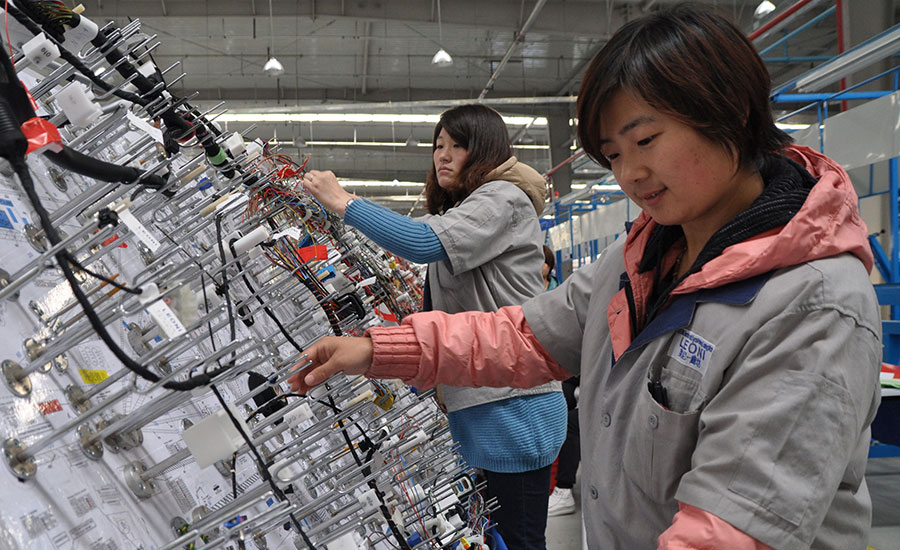
KSK adds much more variety to the production line because each harness might be slightly different from the next. Photo courtesy Leoni AG
According to Burcicki, the manufacturing method is successful due to its high levels of efficiency and flexibility, controlled logistics and planning. “It leads to a unique product,” he points out.
“KSK is important for OEMs as a complete concept,” explains Burcicki. “KSK will equal zero giveaways, which saves material, production time, energy and overall weight, which in turn will save money and help with sustainability goals.
“KSK includes controlled logistics,” Burcicki points out. “There is no harness stock and, therefore, no obsolete harness due to changes. KSK gives minimum limitations that the [OEM] customer can do for each individual car configuration according to the [vehicle] architecture.”
“Additionally, [fewer] wasted materials increases sustainability,” says Burcicki. “You are producing only what you need. This method also introduces an unlimited number of variants, controlled logistics with optimal work-in-progress, a flexible sales strategy, a modifiable production program, modular change management and the ability for the final customer to change the car content according to the logistics window.”
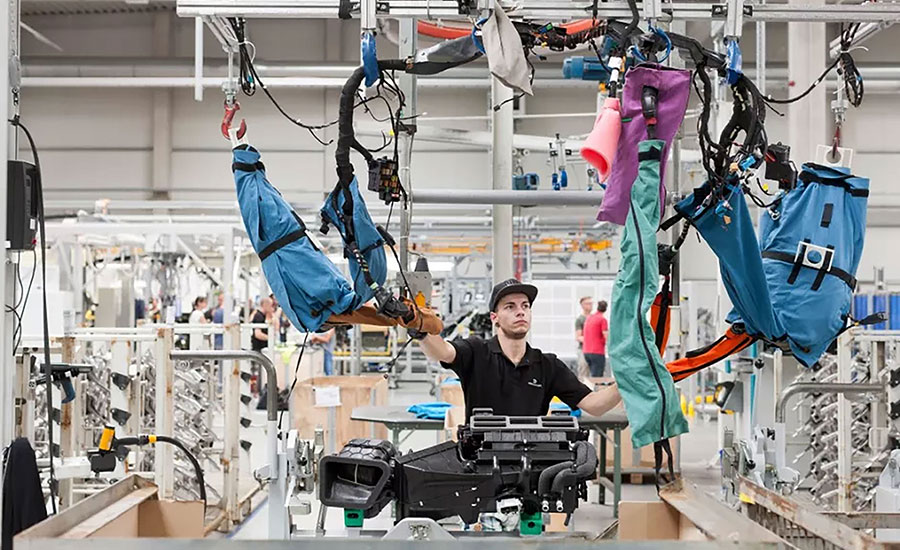
The biggest challenge to KSK conformance is planning and timing. Photo courtesy Dräxlmaier Group
Assembly and Test Challenges
In addition to numerous advantages, the KSK method changes the way that wire harnesses are assembled and tested.
“Much more planning is required to coordinate materials to the production line and test procedures along the way,” says Boyd. “Manufacturing execution system (MES) software plays a big role to coordinate the orchestra of machines and processes.
“The biggest change from traditional harness production is variety,” explains Boyd. “It is easier to make 1,000 units each of three or four versions rather than making one unit each of hundreds of versions. It also affects lead time. KSK is more complex in planning and manufacturing, so the lead time is extraordinarily long.
“The biggest challenge to KSK conformance is planning and timing,” claims Boyd. “Most OEMs want just-in-time production. Coordinating production to coincide with when the harness is needed on the automaker’s final assembly line is a challenge.”
KSK wire harnesses also change the way that products are designed.
“KSK design is on a modular basis,” says Burcicki. “Architecture is for unlimited numbers of variants with just technical limitations. There are several modularization concepts, depending on the OEM strategy. Most important is the correct assignation of material for all combinations, without duplication or missing components.
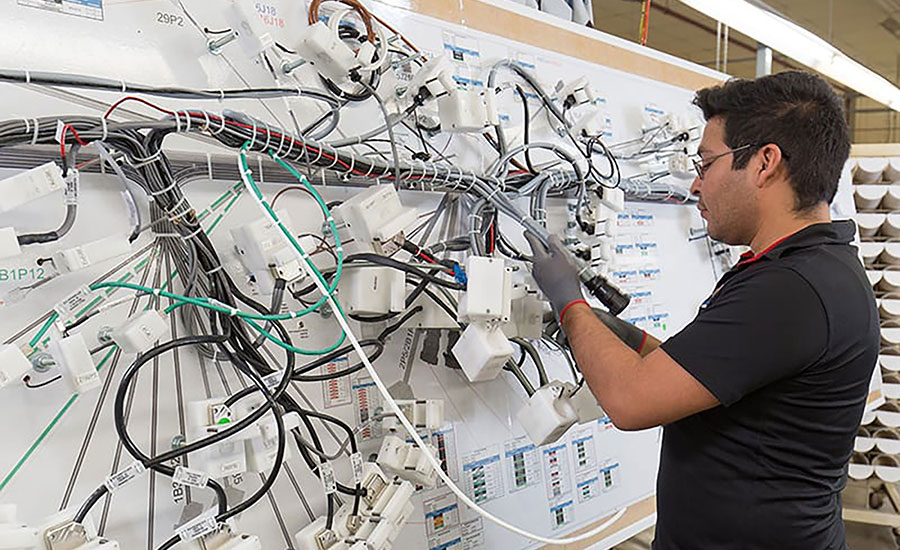
The KSK method changes the way that wire harnesses are designed, assembled and tested. Photo courtesy NAI Group
“The biggest difference from traditional wire harness design is in the data complexity and having a correct project set up,” Burcicki points out. “In the KSK concept, a project needs to be synchronized through design, logistics and production, and this is a challenge.
“Manufacturers can optimize harness production for modularization, design rule check, creating modules and value analysis, and value engineering activities by using advanced harness engineering software,” claims Burcicki.
“These production modules support efficient manufacturing without limiting flexibility and intensely focus on change management,” notes Burcicki. “Software for manufacturing can support production modules, harness analysis, bill-of-process, form board preparation and work instructions for operators.”
Software such as Capital from the Siemens Xcelerator portfolio can handle a variety of tasks, including modularization, production module preparation, board optimization, time calculation, line balancing, change management, standard work instructions and production reports.
“[Engineers] can create fully detailed and validated harness designs with the data-centric architecture of Capital and tap into the seamless integration of Siemens Xcelerator to power their PLM with Teamcenter,” says Burcicki.
“KSK production generates and consumes large amounts of data daily,” warns Burcicki. “This data is critical to the efficient operation of the production system. However, data alone is not enough.
“Harness manufacturers must be able to gather data quickly, sort and filter out essential data, and analyze it to derive insight into the production process,” explains Burcicki. “This is possible with a digital twin approach using a comprehensive electrical-electronic systems development [software] for KSK.”
Other software designed to help coordinate and control the KSK wire harness production process includes 4Wire cutting area optimization (CAO) and Px from DiIT GmbH.
“The two systems together enable complete documentation of production and comprehensive traceability,” says Schleuniger’s Boyd. “4Wire Px is extremely flexible and able to control the most varied of production processes, such as crimping, twisting, welding or injection molding.”
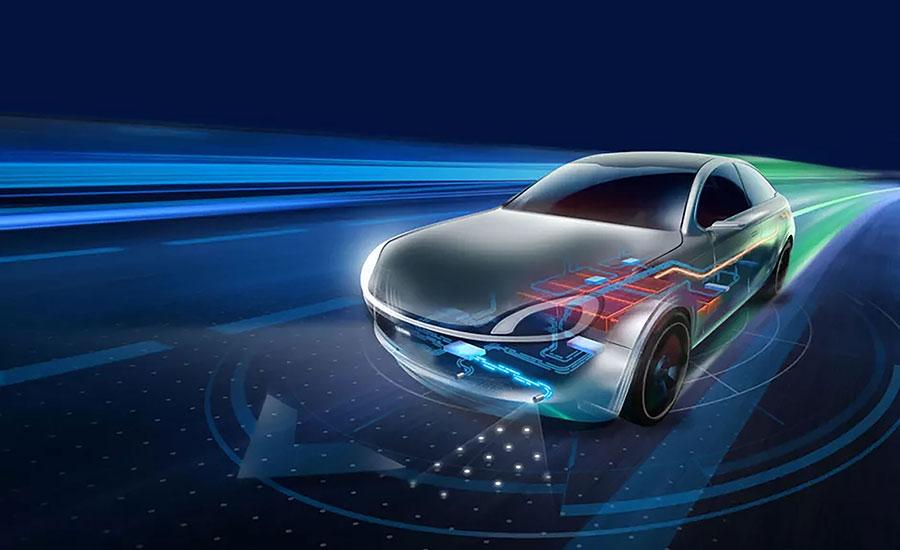
In the future, zonal architectures will be more widely used in the auto industry. Illustration courtesy Leoni AG
Changes Ahead?
Traditional KSK production approaches could soon become irrelevant as manufacturers undergo digital transformation.
“Due to its complexity, KSK requires strong communication, data coherency and a robust data flow between disciplines from the request for quotation stages to production,” says Burcicki. “Harness [assemblers] must seek to eliminate silos between all significant business disciplines for a successful KSK manufacturing system.”
“Harness architecture will be shifting in the future, especially with electric vehicles,” adds Boyd. “Currently, you might say that the architecture is a ‘central architecture’ where all wires come back to a central location.
“This makes the harnesses and the individual wires longer overall,” explains Boyd. “It also makes full automation more difficult, if not impossible.
“In the future, OEMs will implement bus systems in their vehicles and the architecture will shift to a ‘zonal architecture,’” Boyd points out. “This will allow the different zone harnesses to be smaller and much easier to automate. However, this will also mean that the KSK harness production philosophy will fade out and will likely be gone within the next 10 years or so.”
New Wire Processing Products
Machine Automatically Cuts, Strips Wire
Side-Entry Terminal Blocks
Connectors and Terminals for Alarm, Security Applications
Tester Measures Leakage at Low Voltage
Bulkhead Routes Cables at 90 Degrees
Sleeves Bundle Automotive Wire Harnesses


